Financial Management Report: Financial Analysis and Strategies
VerifiedAdded on 2022/12/16
|10
|2286
|80
Report
AI Summary
This report provides a comprehensive overview of financial management, emphasizing its importance in business operations. It defines financial management as the planning, organization, and monitoring of financial resources to improve a firm's performance. The report explores the benefits of financial management, including promoting financial growth, ensuring optimal cash flow, and enabling strategic investment decisions. It then delves into financial statements, specifically balance sheets, income statements, and cash flow statements, highlighting their roles in assessing a company's financial position and profitability. Furthermore, the report discusses the use of ratio analysis, including net profit ratio, gross profit ratio, current ratio, and quick ratio, as tools for decision-making, comparison, and forecasting within a business. The analysis of these ratios provides insights into a company's efficiency, profitability, and liquidity, concluding with the importance of effective financial management practices for business success.

Individual Report
Paraphrase This Document
Need a fresh take? Get an instant paraphrase of this document with our AI Paraphraser
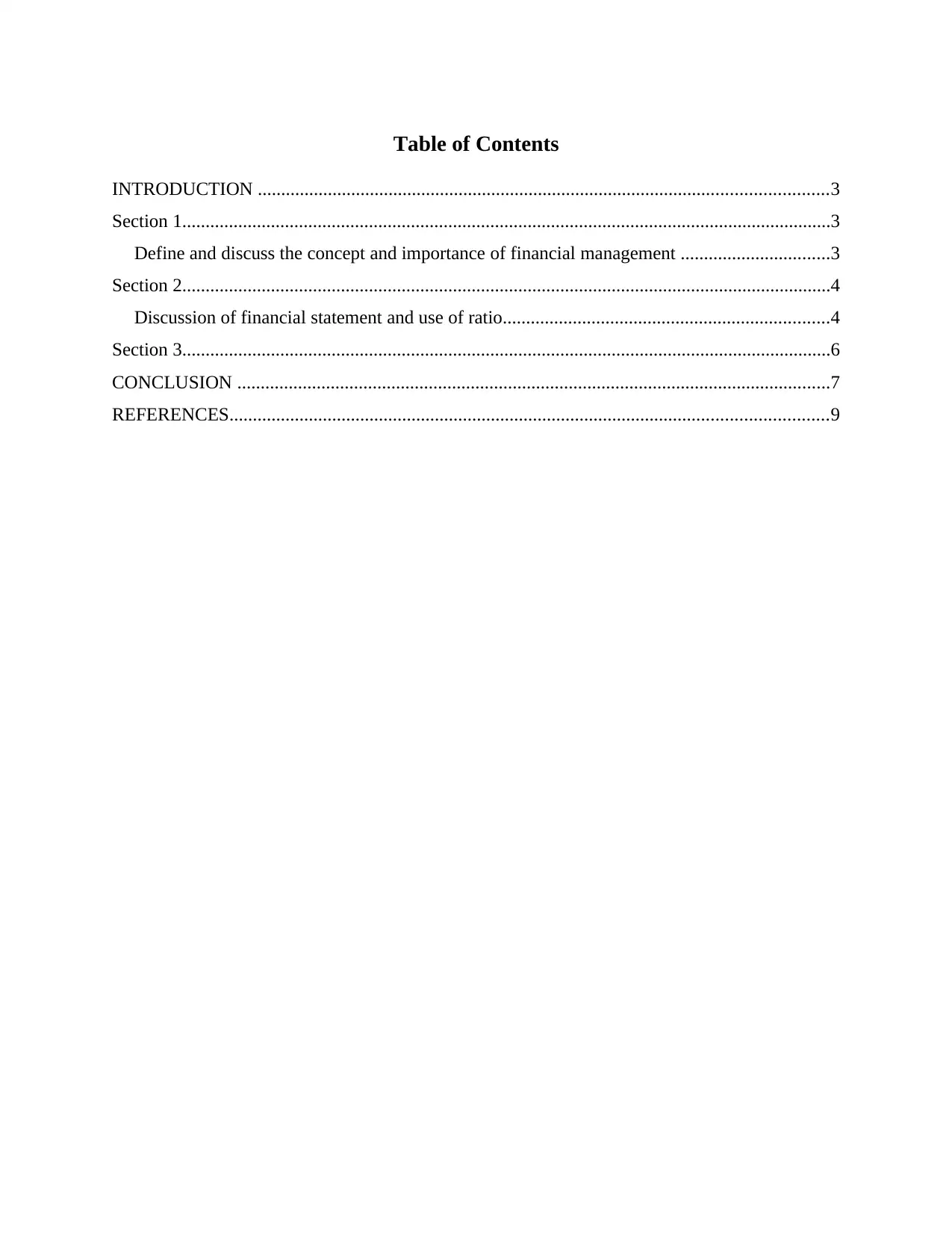
Table of Contents
INTRODUCTION ..........................................................................................................................3
Section 1...........................................................................................................................................3
Define and discuss the concept and importance of financial management ................................3
Section 2...........................................................................................................................................4
Discussion of financial statement and use of ratio......................................................................4
Section 3...........................................................................................................................................6
CONCLUSION ...............................................................................................................................7
REFERENCES................................................................................................................................9
INTRODUCTION ..........................................................................................................................3
Section 1...........................................................................................................................................3
Define and discuss the concept and importance of financial management ................................3
Section 2...........................................................................................................................................4
Discussion of financial statement and use of ratio......................................................................4
Section 3...........................................................................................................................................6
CONCLUSION ...............................................................................................................................7
REFERENCES................................................................................................................................9
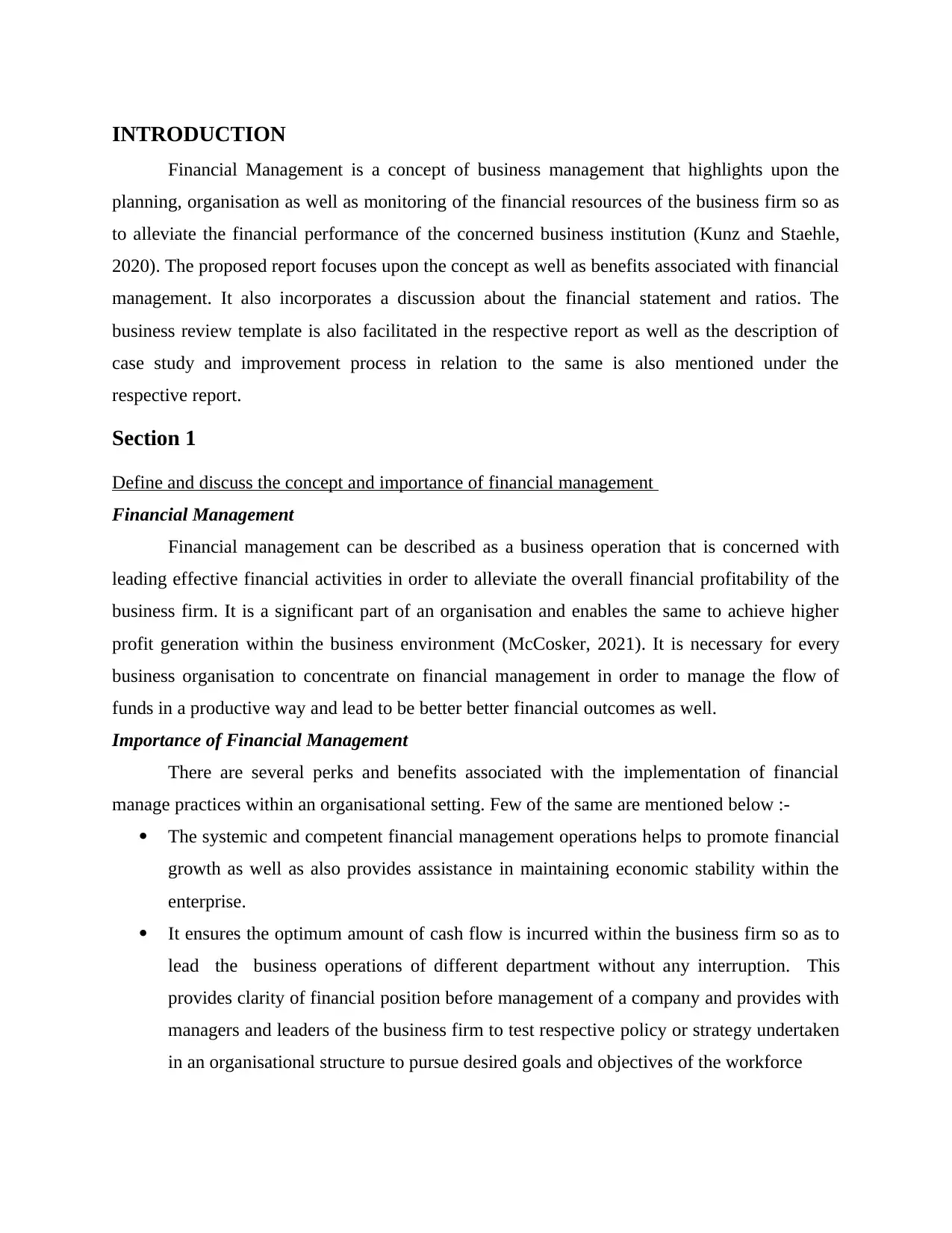
INTRODUCTION
Financial Management is a concept of business management that highlights upon the
planning, organisation as well as monitoring of the financial resources of the business firm so as
to alleviate the financial performance of the concerned business institution (Kunz and Staehle,
2020). The proposed report focuses upon the concept as well as benefits associated with financial
management. It also incorporates a discussion about the financial statement and ratios. The
business review template is also facilitated in the respective report as well as the description of
case study and improvement process in relation to the same is also mentioned under the
respective report.
Section 1
Define and discuss the concept and importance of financial management
Financial Management
Financial management can be described as a business operation that is concerned with
leading effective financial activities in order to alleviate the overall financial profitability of the
business firm. It is a significant part of an organisation and enables the same to achieve higher
profit generation within the business environment (McCosker, 2021). It is necessary for every
business organisation to concentrate on financial management in order to manage the flow of
funds in a productive way and lead to be better better financial outcomes as well.
Importance of Financial Management
There are several perks and benefits associated with the implementation of financial
manage practices within an organisational setting. Few of the same are mentioned below :-
The systemic and competent financial management operations helps to promote financial
growth as well as also provides assistance in maintaining economic stability within the
enterprise.
It ensures the optimum amount of cash flow is incurred within the business firm so as to
lead the business operations of different department without any interruption. This
provides clarity of financial position before management of a company and provides with
managers and leaders of the business firm to test respective policy or strategy undertaken
in an organisational structure to pursue desired goals and objectives of the workforce
Financial Management is a concept of business management that highlights upon the
planning, organisation as well as monitoring of the financial resources of the business firm so as
to alleviate the financial performance of the concerned business institution (Kunz and Staehle,
2020). The proposed report focuses upon the concept as well as benefits associated with financial
management. It also incorporates a discussion about the financial statement and ratios. The
business review template is also facilitated in the respective report as well as the description of
case study and improvement process in relation to the same is also mentioned under the
respective report.
Section 1
Define and discuss the concept and importance of financial management
Financial Management
Financial management can be described as a business operation that is concerned with
leading effective financial activities in order to alleviate the overall financial profitability of the
business firm. It is a significant part of an organisation and enables the same to achieve higher
profit generation within the business environment (McCosker, 2021). It is necessary for every
business organisation to concentrate on financial management in order to manage the flow of
funds in a productive way and lead to be better better financial outcomes as well.
Importance of Financial Management
There are several perks and benefits associated with the implementation of financial
manage practices within an organisational setting. Few of the same are mentioned below :-
The systemic and competent financial management operations helps to promote financial
growth as well as also provides assistance in maintaining economic stability within the
enterprise.
It ensures the optimum amount of cash flow is incurred within the business firm so as to
lead the business operations of different department without any interruption. This
provides clarity of financial position before management of a company and provides with
managers and leaders of the business firm to test respective policy or strategy undertaken
in an organisational structure to pursue desired goals and objectives of the workforce
⊘ This is a preview!⊘
Do you want full access?
Subscribe today to unlock all pages.

Trusted by 1+ million students worldwide
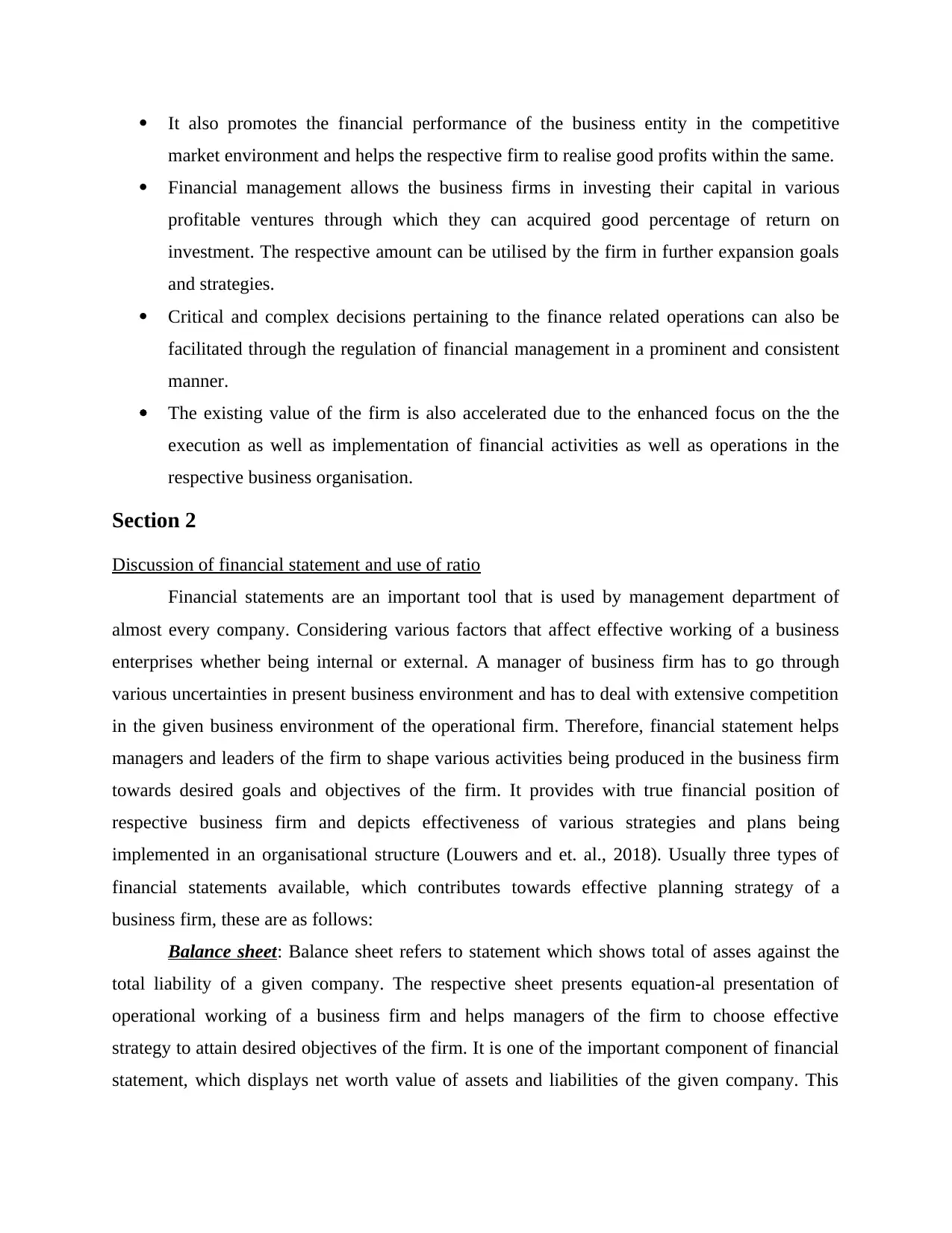
It also promotes the financial performance of the business entity in the competitive
market environment and helps the respective firm to realise good profits within the same.
Financial management allows the business firms in investing their capital in various
profitable ventures through which they can acquired good percentage of return on
investment. The respective amount can be utilised by the firm in further expansion goals
and strategies.
Critical and complex decisions pertaining to the finance related operations can also be
facilitated through the regulation of financial management in a prominent and consistent
manner.
The existing value of the firm is also accelerated due to the enhanced focus on the the
execution as well as implementation of financial activities as well as operations in the
respective business organisation.
Section 2
Discussion of financial statement and use of ratio
Financial statements are an important tool that is used by management department of
almost every company. Considering various factors that affect effective working of a business
enterprises whether being internal or external. A manager of business firm has to go through
various uncertainties in present business environment and has to deal with extensive competition
in the given business environment of the operational firm. Therefore, financial statement helps
managers and leaders of the firm to shape various activities being produced in the business firm
towards desired goals and objectives of the firm. It provides with true financial position of
respective business firm and depicts effectiveness of various strategies and plans being
implemented in an organisational structure (Louwers and et. al., 2018). Usually three types of
financial statements available, which contributes towards effective planning strategy of a
business firm, these are as follows:
Balance sheet: Balance sheet refers to statement which shows total of asses against the
total liability of a given company. The respective sheet presents equation-al presentation of
operational working of a business firm and helps managers of the firm to choose effective
strategy to attain desired objectives of the firm. It is one of the important component of financial
statement, which displays net worth value of assets and liabilities of the given company. This
market environment and helps the respective firm to realise good profits within the same.
Financial management allows the business firms in investing their capital in various
profitable ventures through which they can acquired good percentage of return on
investment. The respective amount can be utilised by the firm in further expansion goals
and strategies.
Critical and complex decisions pertaining to the finance related operations can also be
facilitated through the regulation of financial management in a prominent and consistent
manner.
The existing value of the firm is also accelerated due to the enhanced focus on the the
execution as well as implementation of financial activities as well as operations in the
respective business organisation.
Section 2
Discussion of financial statement and use of ratio
Financial statements are an important tool that is used by management department of
almost every company. Considering various factors that affect effective working of a business
enterprises whether being internal or external. A manager of business firm has to go through
various uncertainties in present business environment and has to deal with extensive competition
in the given business environment of the operational firm. Therefore, financial statement helps
managers and leaders of the firm to shape various activities being produced in the business firm
towards desired goals and objectives of the firm. It provides with true financial position of
respective business firm and depicts effectiveness of various strategies and plans being
implemented in an organisational structure (Louwers and et. al., 2018). Usually three types of
financial statements available, which contributes towards effective planning strategy of a
business firm, these are as follows:
Balance sheet: Balance sheet refers to statement which shows total of asses against the
total liability of a given company. The respective sheet presents equation-al presentation of
operational working of a business firm and helps managers of the firm to choose effective
strategy to attain desired objectives of the firm. It is one of the important component of financial
statement, which displays net worth value of assets and liabilities of the given company. This
Paraphrase This Document
Need a fresh take? Get an instant paraphrase of this document with our AI Paraphraser
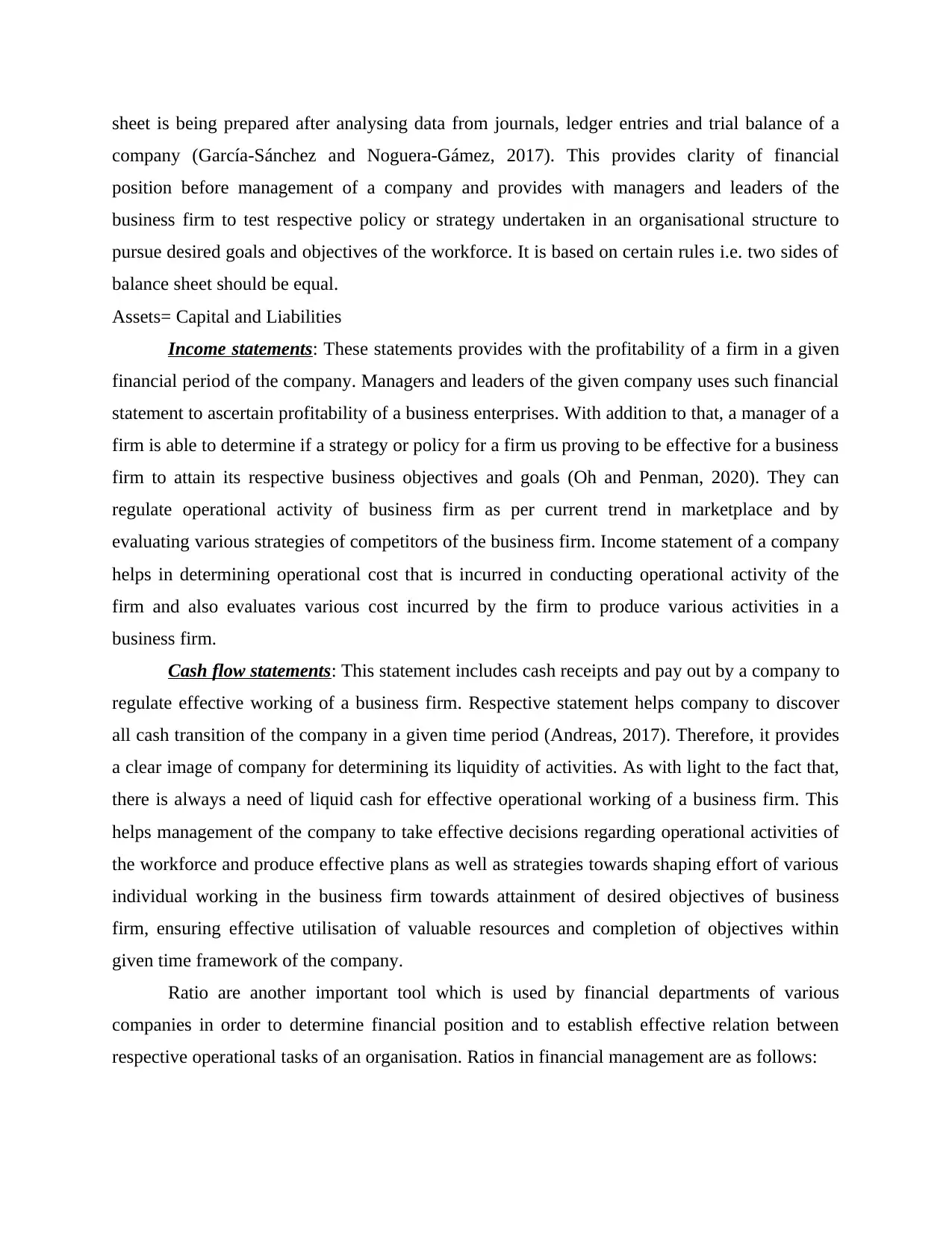
sheet is being prepared after analysing data from journals, ledger entries and trial balance of a
company (García‐Sánchez and Noguera‐Gámez, 2017). This provides clarity of financial
position before management of a company and provides with managers and leaders of the
business firm to test respective policy or strategy undertaken in an organisational structure to
pursue desired goals and objectives of the workforce. It is based on certain rules i.e. two sides of
balance sheet should be equal.
Assets= Capital and Liabilities
Income statements: These statements provides with the profitability of a firm in a given
financial period of the company. Managers and leaders of the given company uses such financial
statement to ascertain profitability of a business enterprises. With addition to that, a manager of a
firm is able to determine if a strategy or policy for a firm us proving to be effective for a business
firm to attain its respective business objectives and goals (Oh and Penman, 2020). They can
regulate operational activity of business firm as per current trend in marketplace and by
evaluating various strategies of competitors of the business firm. Income statement of a company
helps in determining operational cost that is incurred in conducting operational activity of the
firm and also evaluates various cost incurred by the firm to produce various activities in a
business firm.
Cash flow statements: This statement includes cash receipts and pay out by a company to
regulate effective working of a business firm. Respective statement helps company to discover
all cash transition of the company in a given time period (Andreas, 2017). Therefore, it provides
a clear image of company for determining its liquidity of activities. As with light to the fact that,
there is always a need of liquid cash for effective operational working of a business firm. This
helps management of the company to take effective decisions regarding operational activities of
the workforce and produce effective plans as well as strategies towards shaping effort of various
individual working in the business firm towards attainment of desired objectives of business
firm, ensuring effective utilisation of valuable resources and completion of objectives within
given time framework of the company.
Ratio are another important tool which is used by financial departments of various
companies in order to determine financial position and to establish effective relation between
respective operational tasks of an organisation. Ratios in financial management are as follows:
company (García‐Sánchez and Noguera‐Gámez, 2017). This provides clarity of financial
position before management of a company and provides with managers and leaders of the
business firm to test respective policy or strategy undertaken in an organisational structure to
pursue desired goals and objectives of the workforce. It is based on certain rules i.e. two sides of
balance sheet should be equal.
Assets= Capital and Liabilities
Income statements: These statements provides with the profitability of a firm in a given
financial period of the company. Managers and leaders of the given company uses such financial
statement to ascertain profitability of a business enterprises. With addition to that, a manager of a
firm is able to determine if a strategy or policy for a firm us proving to be effective for a business
firm to attain its respective business objectives and goals (Oh and Penman, 2020). They can
regulate operational activity of business firm as per current trend in marketplace and by
evaluating various strategies of competitors of the business firm. Income statement of a company
helps in determining operational cost that is incurred in conducting operational activity of the
firm and also evaluates various cost incurred by the firm to produce various activities in a
business firm.
Cash flow statements: This statement includes cash receipts and pay out by a company to
regulate effective working of a business firm. Respective statement helps company to discover
all cash transition of the company in a given time period (Andreas, 2017). Therefore, it provides
a clear image of company for determining its liquidity of activities. As with light to the fact that,
there is always a need of liquid cash for effective operational working of a business firm. This
helps management of the company to take effective decisions regarding operational activities of
the workforce and produce effective plans as well as strategies towards shaping effort of various
individual working in the business firm towards attainment of desired objectives of business
firm, ensuring effective utilisation of valuable resources and completion of objectives within
given time framework of the company.
Ratio are another important tool which is used by financial departments of various
companies in order to determine financial position and to establish effective relation between
respective operational tasks of an organisation. Ratios in financial management are as follows:

Helps in decision making: By using ratio analysis managers of the firm are able to
formulate and effective plan or strategy in operating respective operational tasks of a
business firm. With addition to that, by its offering of wide variety of clarity and
formulate explanation of operational activities of a company. It also allows regulation of
required changes to be made in strategic plans as well as strategies being formulated in an
organisational structure as per trending needs and wants of various customers of the
company in given marketplace. Useful in comparing: By using tool of ratio analysis financial department of a company
is able to present comparison between working of respective departments of the firm. For
instance it establishes relations between sales and finance department of the business firm
and thus, arranges effective coordination between both of department (Campbell and et.
al., 2019). This ensures effective working of a business firm as both of the department are
pretty useful for the business firm and their activity should be well coordinated.
Managers of the firm by comparing various results of respective departments of the firm
could introduce various innovative strategies and plans for ensuring working of the firm
as per current trends in market of the company.
Enable forecasting: By using ratio analysis, managers of the firm are able to forecast
various decisions of the firm. This helps firm to grasp future opportunities to a business
firm and also provides better competitive advantage to firm (Fleckenstein and Longstaff,
2020). With addition to that, management department of the firm is able to deal with
presence of uncertainties in current business environment and enables firm's effective
functioning in such conditions. By drawing out statical information for operational
activities of a business firm managers of the firm are able to regulate effective working of
a business firm, considering various internal as well as external factors present in
company's environment.
Section 3
Net profit ratio: It is concerned with net profitability of a business enterprise. This ratio
is used for comparing profitability of a business enterprise in accordance with deducting all the
expenses to be incurred for performing sales activities of a business firm.
Net profit ratio: Net profit/ Total sales*100
=43057/189711*100
formulate and effective plan or strategy in operating respective operational tasks of a
business firm. With addition to that, by its offering of wide variety of clarity and
formulate explanation of operational activities of a company. It also allows regulation of
required changes to be made in strategic plans as well as strategies being formulated in an
organisational structure as per trending needs and wants of various customers of the
company in given marketplace. Useful in comparing: By using tool of ratio analysis financial department of a company
is able to present comparison between working of respective departments of the firm. For
instance it establishes relations between sales and finance department of the business firm
and thus, arranges effective coordination between both of department (Campbell and et.
al., 2019). This ensures effective working of a business firm as both of the department are
pretty useful for the business firm and their activity should be well coordinated.
Managers of the firm by comparing various results of respective departments of the firm
could introduce various innovative strategies and plans for ensuring working of the firm
as per current trends in market of the company.
Enable forecasting: By using ratio analysis, managers of the firm are able to forecast
various decisions of the firm. This helps firm to grasp future opportunities to a business
firm and also provides better competitive advantage to firm (Fleckenstein and Longstaff,
2020). With addition to that, management department of the firm is able to deal with
presence of uncertainties in current business environment and enables firm's effective
functioning in such conditions. By drawing out statical information for operational
activities of a business firm managers of the firm are able to regulate effective working of
a business firm, considering various internal as well as external factors present in
company's environment.
Section 3
Net profit ratio: It is concerned with net profitability of a business enterprise. This ratio
is used for comparing profitability of a business enterprise in accordance with deducting all the
expenses to be incurred for performing sales activities of a business firm.
Net profit ratio: Net profit/ Total sales*100
=43057/189711*100
⊘ This is a preview!⊘
Do you want full access?
Subscribe today to unlock all pages.

Trusted by 1+ million students worldwide
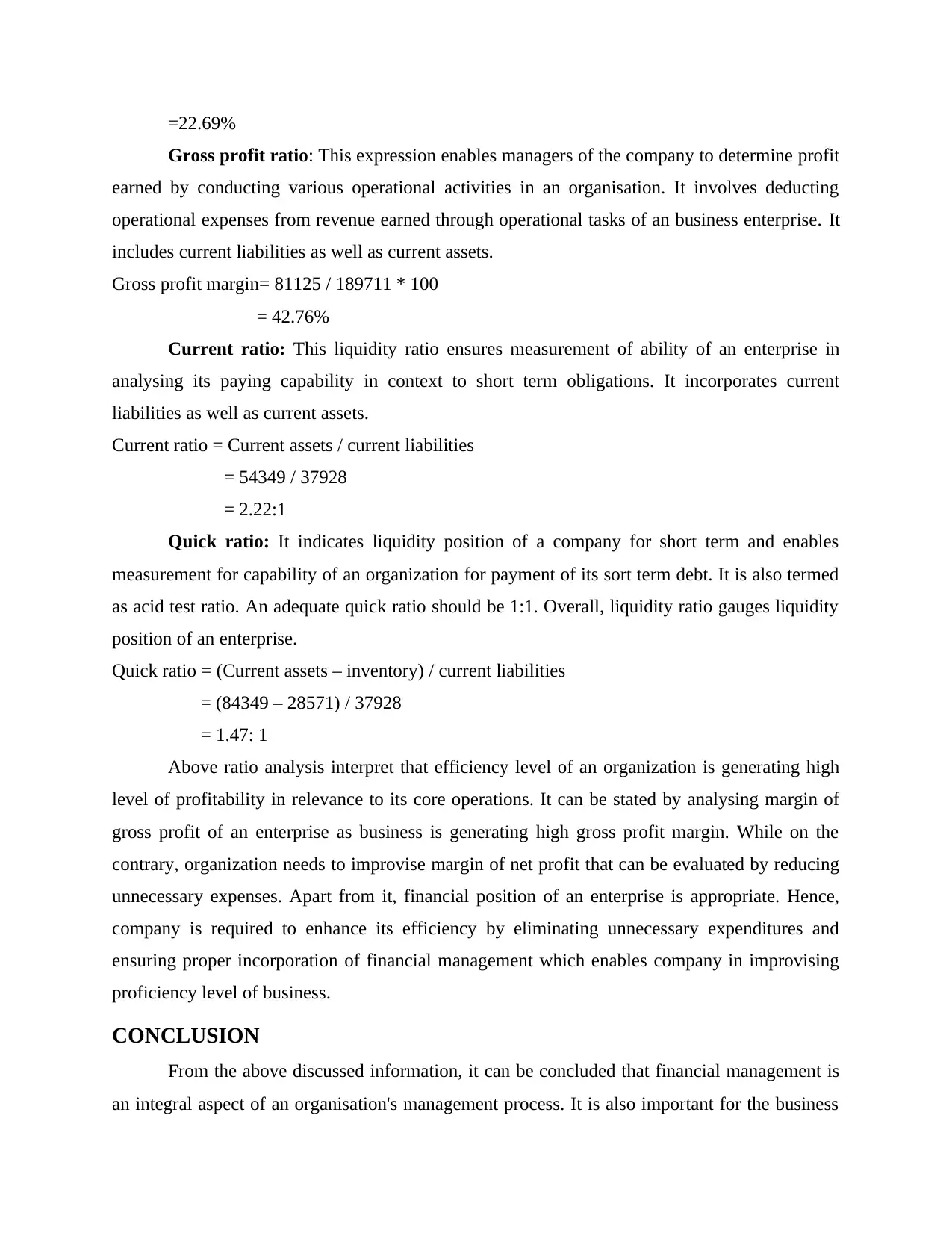
=22.69%
Gross profit ratio: This expression enables managers of the company to determine profit
earned by conducting various operational activities in an organisation. It involves deducting
operational expenses from revenue earned through operational tasks of an business enterprise. It
includes current liabilities as well as current assets.
Gross profit margin= 81125 / 189711 * 100
= 42.76%
Current ratio: This liquidity ratio ensures measurement of ability of an enterprise in
analysing its paying capability in context to short term obligations. It incorporates current
liabilities as well as current assets.
Current ratio = Current assets / current liabilities
= 54349 / 37928
= 2.22:1
Quick ratio: It indicates liquidity position of a company for short term and enables
measurement for capability of an organization for payment of its sort term debt. It is also termed
as acid test ratio. An adequate quick ratio should be 1:1. Overall, liquidity ratio gauges liquidity
position of an enterprise.
Quick ratio = (Current assets – inventory) / current liabilities
= (84349 – 28571) / 37928
= 1.47: 1
Above ratio analysis interpret that efficiency level of an organization is generating high
level of profitability in relevance to its core operations. It can be stated by analysing margin of
gross profit of an enterprise as business is generating high gross profit margin. While on the
contrary, organization needs to improvise margin of net profit that can be evaluated by reducing
unnecessary expenses. Apart from it, financial position of an enterprise is appropriate. Hence,
company is required to enhance its efficiency by eliminating unnecessary expenditures and
ensuring proper incorporation of financial management which enables company in improvising
proficiency level of business.
CONCLUSION
From the above discussed information, it can be concluded that financial management is
an integral aspect of an organisation's management process. It is also important for the business
Gross profit ratio: This expression enables managers of the company to determine profit
earned by conducting various operational activities in an organisation. It involves deducting
operational expenses from revenue earned through operational tasks of an business enterprise. It
includes current liabilities as well as current assets.
Gross profit margin= 81125 / 189711 * 100
= 42.76%
Current ratio: This liquidity ratio ensures measurement of ability of an enterprise in
analysing its paying capability in context to short term obligations. It incorporates current
liabilities as well as current assets.
Current ratio = Current assets / current liabilities
= 54349 / 37928
= 2.22:1
Quick ratio: It indicates liquidity position of a company for short term and enables
measurement for capability of an organization for payment of its sort term debt. It is also termed
as acid test ratio. An adequate quick ratio should be 1:1. Overall, liquidity ratio gauges liquidity
position of an enterprise.
Quick ratio = (Current assets – inventory) / current liabilities
= (84349 – 28571) / 37928
= 1.47: 1
Above ratio analysis interpret that efficiency level of an organization is generating high
level of profitability in relevance to its core operations. It can be stated by analysing margin of
gross profit of an enterprise as business is generating high gross profit margin. While on the
contrary, organization needs to improvise margin of net profit that can be evaluated by reducing
unnecessary expenses. Apart from it, financial position of an enterprise is appropriate. Hence,
company is required to enhance its efficiency by eliminating unnecessary expenditures and
ensuring proper incorporation of financial management which enables company in improvising
proficiency level of business.
CONCLUSION
From the above discussed information, it can be concluded that financial management is
an integral aspect of an organisation's management process. It is also important for the business
Paraphrase This Document
Need a fresh take? Get an instant paraphrase of this document with our AI Paraphraser

firms to have a systemic record of financial data in order to monitor the finances and derive the
annual profits in an organised and accurate manner. The financial information also assists in
better decision making process in the business institution. Overall, it can be stated that it is very
necessary for the firms to exercise good financial practices within their respective operations in
order to leverage from the same in the market domain.
annual profits in an organised and accurate manner. The financial information also assists in
better decision making process in the business institution. Overall, it can be stated that it is very
necessary for the firms to exercise good financial practices within their respective operations in
order to leverage from the same in the market domain.

REFERENCES
Books and Journals
Andreas, A., 2017. Analysis of operating cash flow to detect real activity manipulation and its
effect on market performance. International Journal of Economics and Financial
Issues, 7(1).3
Campbell, J.L. and et. al., 2019. Tax-related mandatory risk factor disclosures, future
profitability, and stock returns. Review of Accounting Studies, 24(1), pp.264-308.
Fleckenstein, M. and Longstaff, F.A., 2020. Renting Balance Sheet Space: Intermediary Balance
Sheet Rental Costs and the Valuation of Derivatives. The Review of Financial
Studies, 33(11), pp.5051-5091.
García‐Sánchez, I.M. and Noguera‐Gámez, L., 2017. Integrated reporting and stakeholder
engagement: The effect on information asymmetry. Corporate Social Responsibility and
Environmental Management, 24(5), pp.395-413.
Kunz, A.H. and Staehle, M., 2020. Recognition versus Disclosure of Future Loss Conditions and
the Decision-Usefulness of Financial Statements. The Accounting Review, 95(5),
pp.247-264.
Louwers, T.J. and et. al., 2018. Auditing & assurance services. McGraw-Hill Education.
McCosker, P., 2021. Interpretation of Financial Statements. Financial and Managerial Aspects in
Human Resource Management: A Practical Guide, Emerald Publishing Limited, pp.23-
37.
Oh, H.I. and Penman, S.H., 2020. Income statement mismatching has not reduced the
information conveyed by accounting over time. Available at SSRN 3778173.
Books and Journals
Andreas, A., 2017. Analysis of operating cash flow to detect real activity manipulation and its
effect on market performance. International Journal of Economics and Financial
Issues, 7(1).3
Campbell, J.L. and et. al., 2019. Tax-related mandatory risk factor disclosures, future
profitability, and stock returns. Review of Accounting Studies, 24(1), pp.264-308.
Fleckenstein, M. and Longstaff, F.A., 2020. Renting Balance Sheet Space: Intermediary Balance
Sheet Rental Costs and the Valuation of Derivatives. The Review of Financial
Studies, 33(11), pp.5051-5091.
García‐Sánchez, I.M. and Noguera‐Gámez, L., 2017. Integrated reporting and stakeholder
engagement: The effect on information asymmetry. Corporate Social Responsibility and
Environmental Management, 24(5), pp.395-413.
Kunz, A.H. and Staehle, M., 2020. Recognition versus Disclosure of Future Loss Conditions and
the Decision-Usefulness of Financial Statements. The Accounting Review, 95(5),
pp.247-264.
Louwers, T.J. and et. al., 2018. Auditing & assurance services. McGraw-Hill Education.
McCosker, P., 2021. Interpretation of Financial Statements. Financial and Managerial Aspects in
Human Resource Management: A Practical Guide, Emerald Publishing Limited, pp.23-
37.
Oh, H.I. and Penman, S.H., 2020. Income statement mismatching has not reduced the
information conveyed by accounting over time. Available at SSRN 3778173.
⊘ This is a preview!⊘
Do you want full access?
Subscribe today to unlock all pages.

Trusted by 1+ million students worldwide

1 out of 10
Related Documents
Your All-in-One AI-Powered Toolkit for Academic Success.
+13062052269
info@desklib.com
Available 24*7 on WhatsApp / Email
![[object Object]](/_next/static/media/star-bottom.7253800d.svg)
Unlock your academic potential
Copyright © 2020–2025 A2Z Services. All Rights Reserved. Developed and managed by ZUCOL.

